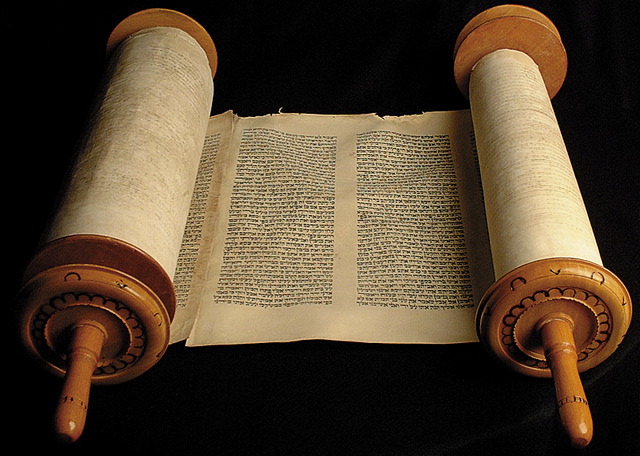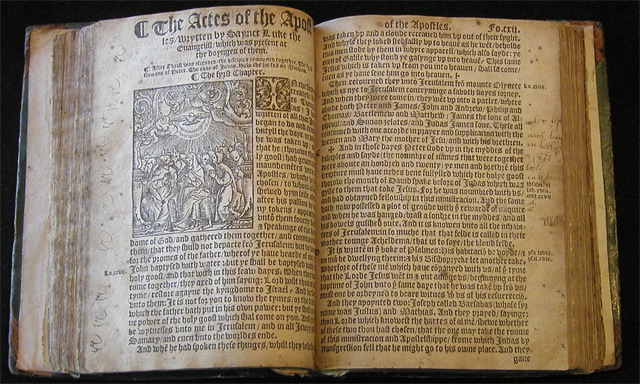Ink & Blood: Dead Sea Scrolls to the English Bible
08/22/2005 10:13 Filed in: Faith & Reason

Above: A medieval Hebrew Bible scroll containing the Masoretic Text.
Saturday, we were finally able to take an afternoon to drive to Lexington and see the traveling exhibit, "Ink & Blood: Dead Sea Scrolls to the English Bible ." Initially, I did not know what to expect. Although the event has been advertised widely in the area I wasn't completely clear on the nature and breadth of the exhibit. Further, I noted that after purchasing my tickets online that I now held two seats for a 1:30 PM showing. In reality, Ink & Blood is a touring museum exhibit on the history of the Bible that contains three different points in which visitors watch video presentations. But most of the time is spent walking through the displays and reading the histories behind the various artifacts and books.
Some of you may or may not know that as a little side hobby of mine I collect different translations of the Bible in English. I currently have over 100 different English translations in my collection. These aren't kept or catalogued with our other books , but perhaps sometime in the future, I will take the time to list them on this blog. Nevertheless, as you might imagine, I was thoroughly engaged in the exhibit Saturday afternoon. What amazed me is the breadth of artifacts to see. I can only imagine the effort to purchase or borrow all the items. There are over 500 items in all, and of these, only four are replicas! Where else can you see authentic Sumerian stone tablets, biblical papyri, codexes of the early Christian church, and first editions of nearly every version of the Bible in English through the 17th century in one place? I was astonished to see the first, second, and third editions of Erasmus' Greek New Testament side by side and to behold up close Bibles I had only read about such as the 1631 edition of the Authorized Version known as "The Wicked Bible" (the word not was "inadvertently" left out of Exodus 20:14).
Ink & Blood also allows you to see up close and personal the Marzeah papyrus which is purported to be the "oldest known Hebrew writing (other than an inscription) in the world today." It dates from the 7th century BC and contains the oldest record of the word "Elohim" (usually translated God in the Bible) in existence. I'll admit up front I wasn't familiar with the Marzeah Papyrus, but I will be interested to look into it further. But again, it's artifacts like this that you just don't get to see everyday that makes this exhibit so valuable.

Above: the Marzeah Papyrus
If you've ever wondered how the Bible came to be, this tour is a great introduction. In reality, there's more than just history of the Bible involved in this exhibit. Visitors are introduced to the historical process of how pictograms gradually became symbols for sounds instead of things and developed into our modern alphabets. This history of the Bible is traced from the earliest writings attested to in the Dead Sea Scrolls through eras where Greek, then Latin languages dominated into the time of John Wycliffe when the idea became popular that every believer should have access to the Scriptures in his or her native language. After this era, emphasis is given to the development of the Bible in English, but there are also displays of Luther's Bible in German and the first Bible in Spanish. William Tyndale is credited for the shift in language from Middle English (around the time of Wycliffe and Chaucer) to the modern era due to the fact that at least 80% of the 1611 King James Version was essentially Tyndale's translation.
In addition to the Bibles, scrolls, parchments, tablets, and other artifacts, there is also a working reproduction of the Gutenberg Press which was used to print the first typeset book--in this case, the Latin Vulgate version of the Bible. The exact nature of Gutenberg's press is not known because it was destroyed and Gutenberg himself was so secretive that he left no blueprints behind or even the recipe he used for ink. However, the press we saw was designed from the best speculation of how Gutenberg's press would have been adapted from the wine presses of the region. This press is demonstrated for visitors, and the pages that are pressed can be purchased in the gift shop for $10. Each page contains a reproduction on the left of the title page from the Book of Psalms in the 1611 KJV Bible and on the right a reproduction (including color accents) of a page from 1 Kings (for Protestants, think 1 Samuel) from the Latin Vulgate as it was printed on Gutenberg's press. These are quite suitable for framing. In fact, we picked one up.
The title for the exhibit comes from the fact that the Bible, written in ink, also came at the cost of the lives of many people over the years, especially those who wanted to see it available for common access in one's own native tongue. The Catholic Church does not fare too well in the history of this process as it only authorized the Latin translation for official use for over 1,000 years, and even most of the Catholic clergy did not have access to that. As individuals like Wycliffe, Luther, and Tyndale began translating the Scriptures into their own languages, they were persecuted endlessly by the Catholic church. Tyndale was strangled and then burned at the stake. Wycliffe and Luther avoided capture, but the church dug up his bones forty years after his death, burned them and scattered them in a river (under the mistaken assumption that this would keep him from experiencing the resurrection from the dead). At the very least, Ink & Blood ought to make you thankful for that Bible you carry in your hand to church on Sunday. In the history of the world, your experience is in the minority.

Above: The 1536 Tyndale New Testament
Dr. William H. Noah is founder and chief curator of Ink and Blood. Noah is actually a medical doctor, but as I read the descriptions and background for the artifacts, I also found him to be a very precise historian. He has done his homework well, and the exhibit does not sensationalize as one might fear an event of this nature, aimed at the general public, might be prone to do. The exhibit is not so academic that it would be inaccessible to the average church-goer, but instead has a goal of teaching visitors the history behind the process of transmission of the ancient scriptures to the modern version that you use today. According to the website, Dr. Noah has completed a four hour documentary on the history of the Bible. The first installment focuses on William Tyndale and is available now.
At the end of the tour, there is a gift shop with a number of interesting items that I haven't seen elsewhere before. However, with our current limited budget, we only picked up one of the Gutenberg press prints and the main book and DVD that went with the exhibit. With so many people in front of me and behind me as I walked through the exhibit, I felt slightly rushed (in spite of taking 2 and a half hours to go through it!), so the book and DVD will allow me to revisit the artifacts at my own pace. In fact the DVD, in addition to the three short films we watched at the exhibit, also contains pictures of every item and all the text descriptions and histories. Too bad that the disk doesn't contain a separate section with images and text that could be easily inserted into a PowerPoint presentation. However, I can always do screen captures, and I've found while writing this blog entry that a number of the images are available at the Ink & Blood website.
Ink & Blood originated in Knoxville, Tennessee and will only be in Lexington, Kentucky through this Saturday (August 28). However, it will be in Charleston, South Carolina this Fall. See the website for exact dates and times. Admission begins at $8 for children (although see my note below) and goes up to $16 for adults. However, there are group rates available and you may be able to stumble upon certain discounts from sponsors.
What You Need to Know First Department: I fully recommend this exhibit to anyone interested in the Bible and its development and influence in history. However, you should be warned ahead of time that except for the three brief video presentations, you will be on your feet for at least two hours, and probably more. For us, the first video began at 1:30 PM (it lasts eight minutes), and we did not complete the exhibit until 4:00 PM and then spent another half hour in the gift shop. Note that there are no bathroom stops (that I saw) along the way. Visitors have to pass through metal detectors going into the exhibit, and all cameras are held until afterwards (so it's probably best just not to bring one). Based on what I observed, this is not really the best place to bring small children. A number of children who were brought along by their parents for the tour, especially ones who could not read, were thoroughly bored despite the best efforts of their guardians to engage them and explain the significance of certain artifacts. And the occasional site of the child walking in procession playing a Gameboy seemed quite disconcerting and out of place. You may also want to try to go during the week since the crowd on Saturday was quite large.









